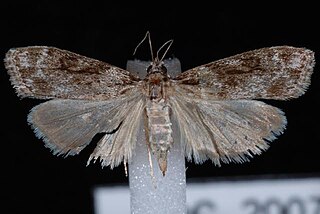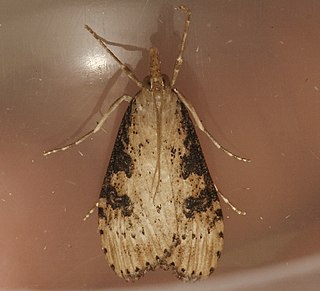Undulambia is a genus of moths of the family Crambidae.

Elophila tinealis, the black duckweed moth, is a moth in the family Crambidae. It was described by Eugene G. Munroe in 1972. It is found in North America, where it has been recorded from Michigan, Ontario and New York, south to Florida and west to Texas. The habitat consists of swamps and wet woods.

Petrophila canadensis, the Canadian petrophila moth, is a moth in the family Crambidae. It was described by Eugene G. Munroe in 1972. It is found in North America, where it has been recorded from southern Canada and the north-eastern United States.
Petrophila hodgesi is a moth in the family Crambidae. It was described by Eugene G. Munroe in 1972. It is found in North America, where it has been recorded from Arkansas and Oklahoma.
Lipocosma septa, the exposed lipocosma moth, is a moth in the family Crambidae. It was described by Eugene G. Munroe in 1972. It is found in North America, where it has been recorded from Florida, Georgia, Maryland, North Carolina, Oklahoma, South Carolina, Texas and Virginia.
Plumegesta largalis is a moth in the family Crambidae. It was described by Eugene G. Munroe in 1972. It is found in North America, where it has been recorded from Florida.
Undulambia fovecosta is a moth in the family Crambidae. It is found in Panama, Guatemala and Costa Rica.
Cosipara modulalis is a moth in the family Crambidae. It was described by Eugene G. Munroe in 1972. It is found in North America, where it has been recorded from Arizona and Colorado.
Eudonia franclemonti is a moth in the family Crambidae. It was described by Eugene G. Munroe in 1972. It is found in North America, where it has been recorded from Arizona.

Eudonia spenceri is a moth in the family Crambidae. It was described by Eugene G. Munroe in 1972. It is found in North America, where it has been recorded from California and Arizona to Montana and British Columbia.
Scoparia apachealis is a moth in the family Crambidae. It was described by Eugene G. Munroe in 1972. It is found in North America, where it has been recorded from Arizona, New Mexico and Utah.
Scoparia dominicki is a moth in the family Crambidae. It was described by Eugene G. Munroe in 1972. It is found in North America, where it has been recorded from Florida, North Carolina, Oklahoma, South Carolina and West Virginia.
Metaxmeste nubicola is a moth in the family Crambidae. It was described by Eugene G. Munroe in 1954. It is found in North America, where it has been recorded from Colorado and Washington. The habitat consists of arctic-alpine areas.
Noctueliopsis brunnealis is a moth in the family Crambidae. It was described by Eugene G. Munroe in 1972. It is found in North America, where it has been recorded from Arizona, California, Nevada, New Mexico and Texas.
Palpita kimballi, or Kimball's palpita moth, is a moth in the family Crambidae. It was described by Eugene G. Munroe in 1959. It is found in North America, where it has been recorded from Alabama, Florida, Georgia, Louisiana, North Carolina, Oklahoma, South Carolina, Tennessee and Virginia.

Palpita freemanalis, or Freeman's palpita moth, is a moth in the family Crambidae. It was described by Eugene G. Munroe in 1952. It is found in North America, where it has been recorded from Alabama, Illinois, Indiana, Louisiana, Maryland, Mississippi, North Carolina, Oklahoma, South Carolina, Tennessee and Texas.
Udea beringialis is a moth in the family Crambidae. It was described by Eugene G. Munroe in 1966. It is found in North America, where it has been recorded from Alaska, Alberta, British Columbia, Manitoba and the Yukon Territory.
Udea brevipalpis is a moth in the family Crambidae. It was described by Eugene G. Munroe in 1966. It is found in North America, where it has been recorded from California, Colorado and Utah.
Udea cacuminicola is a moth in the family Crambidae. It was described by Eugene G. Munroe in 1966. It is found in North America, where it has been recorded from Colorado and Wyoming.

Udea livida is a moth in the family Crambidae. It was described by Eugene G. Munroe in 1966. It is found in North America, where it has been recorded from British Columbia, Washington and Utah.




